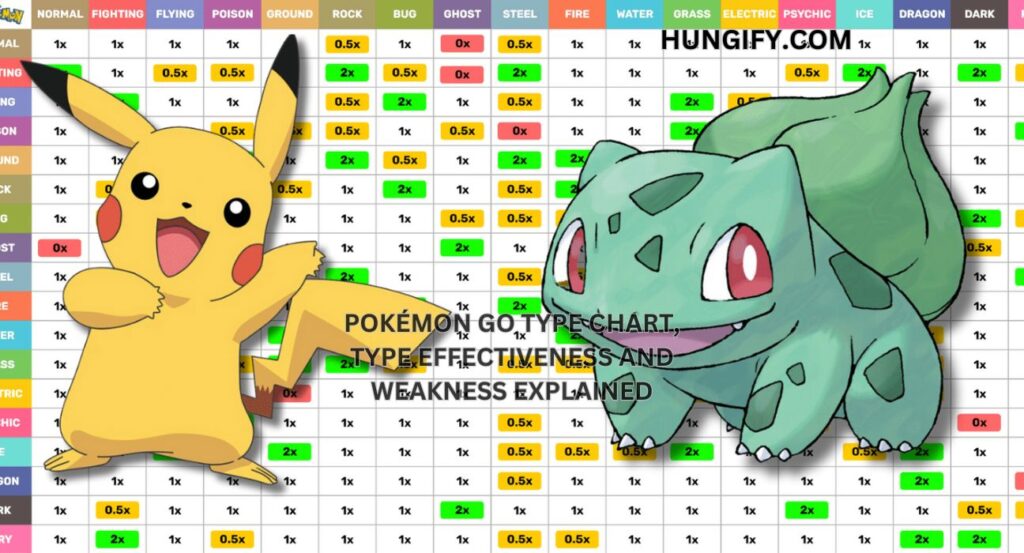Understanding the Pokémon Go Type chart, Type effectiveness and weakness explained is crucial for any trainer looking to succeed in battles. Whether you’re planning for raids, gym battles, or player vs. player (PvP) combat, knowing which Pokémon types are strong or weak against others gives you a strategic edge. In this guide, we’ll explain how type effectiveness works, highlight type weaknesses, and help you build a balanced team to dominate your battles.
Read More: Xbox’s new Game Pass Standard tier yanks access to Starfield, Hellblade 2, Diablo 4, and more
Introduction to Pokémon Go Type Chart
Why Understanding Type Effectiveness is Important in Pokémon Go
In Pokémon Go, mastering the type chart is the key to winning battles. Each Pokémon belongs to one or two types, and the effectiveness of their attacks depends on their type compared to their opponent’s. Some types have advantages over others, while some are vulnerable to specific attacks. Learning the type matchups allows you to deal more damage and avoid losing battles easily.
How Type Advantages Differ from the Mainline Pokémon Games
While Pokémon Go follows similar type mechanics as the mainline games, there are a few differences. For example, the damage multiplier for super effective moves in Pokémon Go is 1.6x, while in the main series, it’s 2x. Immunities in Pokémon Go are treated as resistances, meaning no Pokémon is completely immune to damage, but the damage they receive may be significantly reduced.
Pokémon Go Type Chart Breakdown
Overview of All 18 Pokémon Types
There are 18 types in Pokémon Go, each with its own strengths and weaknesses. These types include:
- Normal
- Fire
- Water
- Grass
- Electric
- Ice
- Fighting
- Poison
- Ground
- Flying
- Psychic
- Bug
- Rock
- Ghost
- Dragon
- Dark
- Steel
- Fairy
The Role of Dual-Type Pokémon in Battle
Many Pokémon have dual types, which means they belong to two different types simultaneously. This can be both an advantage and a disadvantage. Dual-type Pokémon have more options for resistances and weaknesses, but they can also be doubly weak to certain types. For example, a Dragon/Flying Pokémon like Rayquaza is highly vulnerable to Ice-type moves.
How Damage Multipliers Work in Pokémon Go
The effectiveness of a Pokémon’s move is determined by type advantages and resistances. Here’s how the damage multipliers break down in Pokémon Go:
- Super Effective: 1.6x damage
- Neutral: 1x damage
- Not Very Effective: 0.625x damage
- Double Super Effective: 2.56x damage
- Double Resistant: 0.39x damage
Understanding these multipliers helps you calculate how much damage you can deal in any given battle.

Strengths and Weaknesses for Each Pokémon Type
Fire Type Strengths and Weaknesses
- Strong Against: Grass, Ice, Bug, Steel
- Weak Against: Water, Rock, Fire, Dragon
- Resistant To: Bug, Steel, Fire, Grass, Ice, Fairy
- Vulnerable To: Water, Rock, Ground
Water Type Strengths and Weaknesses
- Strong Against: Fire, Ground, Rock
- Weak Against: Water, Grass, Dragon
- Resistant To: Fire, Water, Ice, Steel
- Vulnerable To: Electric, Grass
Grass Type Strengths and Weaknesses
- Strong Against: Water, Ground, Rock
- Weak Against: Fire, Flying, Poison, Bug, Steel
- Resistant To: Water, Electric, Grass, Ground
- Vulnerable To: Fire, Ice, Flying, Poison, Bug
Electric Type Strengths and Weaknesses
- Strong Against: Water, Flying
- Weak Against: Ground, Electric, Grass
- Resistant To: Electric, Flying, Steel
- Vulnerable To: Ground
Dark Type Strengths and Weaknesses
- Strong Against: Psychic, Ghost
- Weak Against: Fighting, Bug, Fairy
- Resistant To: Ghost, Dark, Psychic
- Vulnerable To: Fighting, Bug, Fairy
Read More: Suicide Squad Kill the Justice League: Everything You Need to Know
Pokémon Go Type Matchups and Best Counters
Super Effective and Double Super Effective Matchups
In Pokémon Go, when you use a move that is super effective against your opponent’s type, it will deal 1.6x damage. If your opponent is doubly weak to your move (for example, a Dragon/Flying type hit by an Ice move), it will deal 2.56x damage. This is why understanding matchups is so important for success in both PvP and raids.
Understanding Immunities and Resistances in Pokémon Go
Unlike in the mainline Pokémon games, immunities don’t exist in Pokémon Go. Instead, a Pokémon that would typically be immune to a type in other games (e.g., Ghost types being immune to Normal moves) will take reduced damage instead. Understanding how resistances work can help you mitigate incoming damage and plan your defensive strategy accordingly.
Building a Balanced Team Using the Type Chart
How to Counter Popular Pokémon in Raids and PvP
When preparing for raids or PvP battles, it’s essential to build a team that covers multiple types. For example, to counter popular Dragon-type raid bosses like Rayquaza, using Ice or Fairy-type Pokémon like Mamoswine or Togekiss will give you a significant advantage. You should also consider having dual-type Pokémon that resist multiple types of attacks to give you more versatility.
Tips for Using Dual-Type Pokémon Effectively
Dual-type Pokémon can offer a lot of flexibility in battles, but they also come with increased risk due to additional weaknesses. When choosing dual-type Pokémon, try to balance their strengths and weaknesses. For instance, Swampert, a Water/Ground type, is highly effective in both PvP and raids due to its ability to counter Electric-type Pokémon while resisting Fire, Rock, and Steel-type moves.
Understanding Dual-Type Pokémon in Pokémon Go
Dual-type Pokémon in Pokémon Go present both advantages and challenges. While they have more coverage in battles, they are also susceptible to additional weaknesses. For example, Flying/Dragon Pokémon like Dragonite have several weaknesses, including Ice-type moves. Understanding how these dual types work can make a big difference in your battle strategy.
How Weather Boost Affects Type Effectiveness in Pokémon Go
Weather in Pokémon Go plays a crucial role in enhancing the effectiveness of certain types. For instance, Sunny weather boosts Fire, Grass, and Ground-type moves, giving them more power in battles. Using the type chart alongside weather conditions allows you to maximize damage and improve your performance in raids and PvP.
Type Resistances: Key to Defense in Pokémon Go
Defensive strategies in Pokémon Go hinge on type resistances. Certain Pokémon types resist attacks from specific types, taking reduced damage. For example, Steel-types are resistant to Ice, Rock, and Fairy moves. Choosing Pokémon with strong resistances can help you last longer in difficult battles.
Type Matchups in Pokémon Go Raids
In Pokémon Go Raids, type matchups are critical for defeating powerful raid bosses. Understanding which types to use can dramatically shorten the time needed to defeat the boss. For instance, Ice-type Pokémon are highly effective against Dragon-type raid bosses like Rayquaza due to the type’s double weakness.
How to Build a Well-Rounded Team Using the Pokémon Go Type Chart
A balanced team is essential for success in Pokémon Go. Using the Pokémon Go Type chart, you can select Pokémon that cover various types of weaknesses. For example, having Electric, Fire, and Water-type Pokémon on your team ensures that you can handle a wide range of opponents with different type strengths and weaknesses.

Conclusion: Mastering the Type Chart for Competitive Advantage
Mastering the Pokémon Go Type chart, Type effectiveness and weakness explained is an essential skill for any trainer. By understanding type effectiveness and weakness, you can build stronger teams, plan better strategies, and consistently outperform your opponents. Whether you’re taking on raid bosses or climbing the ranks in PvP battles, using type matchups to your advantage is key to becoming a top trainer.
Incorporate the Pokémon Go Type chart, Type effectiveness and weakness explained into your battle planning, and watch as you achieve more success with each encounter!
Read More: All Pokémon Go Eevee Evolutions: How to Evolve Eevee
Frequently Asked Questions
What is the Pokémon Go Type Chart?
The Pokémon Go Type chart, Type effectiveness and weakness explained outlines how different Pokémon types interact, showing strengths, weaknesses, and resistances in battles.
How does type effectiveness work in Pokémon Go?
Type effectiveness in Pokémon Go determines how much damage a move deals based on type matchups, with moves being super effective or not very effective depending on the types involved.
What is the damage multiplier for super effective moves in Pokémon Go?
In Pokémon Go, super effective moves have a 1.6x damage multiplier, meaning they deal 60% more damage to opponents.
Which Pokémon type is weak against Electric-type moves?
Water and Flying types are weak against Electric-type moves, taking increased damage from them.
Are there type immunities in Pokémon Go?
No, Pokémon Go doesn’t have type immunities, but some Pokémon types can have double resistances, reducing damage to a very low level.
What is the best counter for Dragon-type Pokémon?
Ice, Dragon, and Fairy types are the best counters for Dragon-type Pokémon in Pokémon Go.
How do dual-type Pokémon affect type effectiveness?
Dual-type Pokémon have both strengths and weaknesses based on both types, meaning they can be doubly weak or doubly resistant to certain types.
What is the most effective type in Pokémon Go?
Types like Dragon, Steel, and Fairy are considered among the most effective due to their strong resistances and powerful moves.
How can I build a balanced team using the type chart?
To build a balanced team, ensure you have coverage against multiple types by including Pokémon with diverse strengths and resistances.
What is a double super effective move in Pokémon Go?
A double super effective move occurs when both of a Pokémon’s types are weak to the attack type, dealing 2.56x damage.
